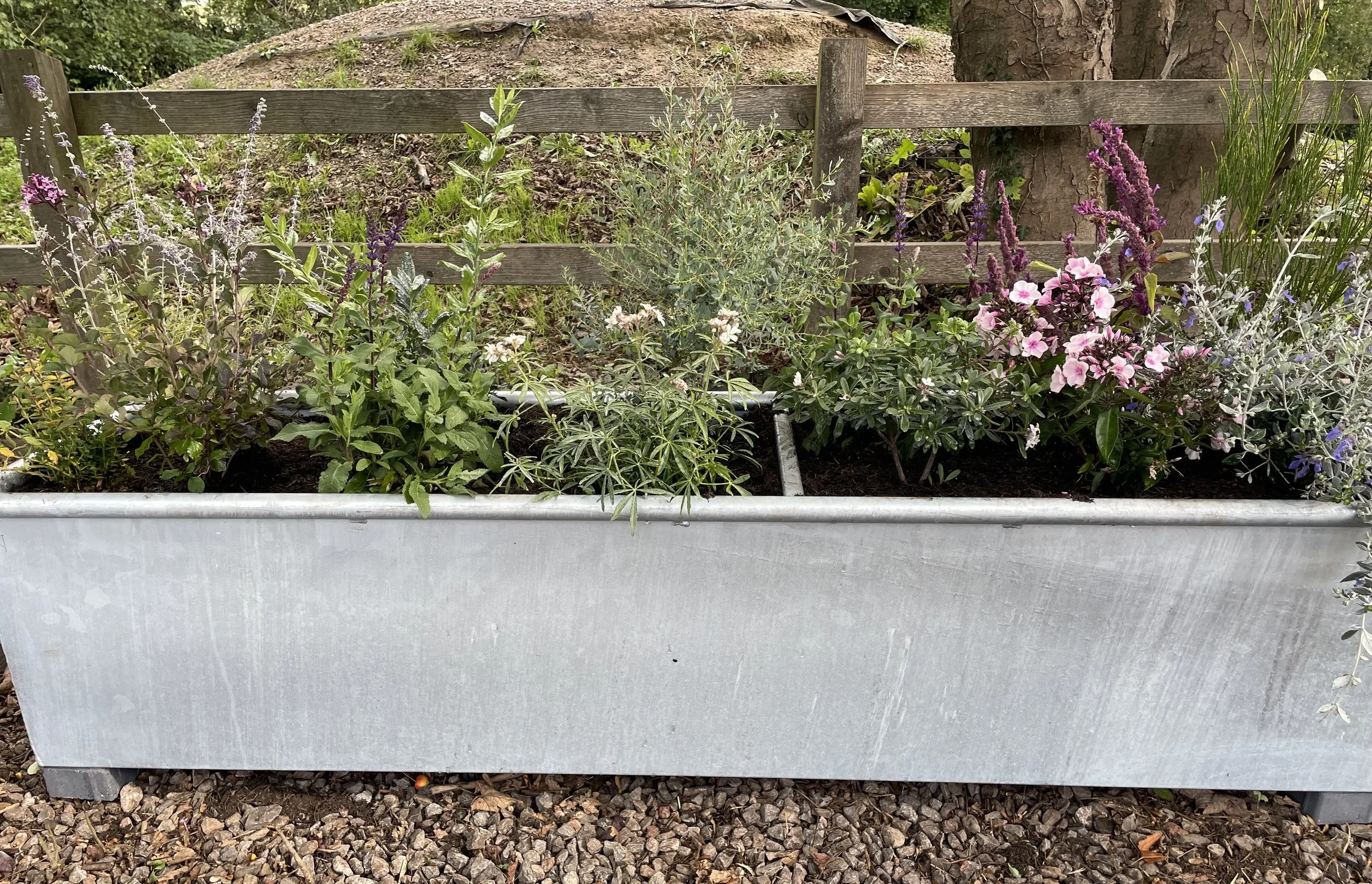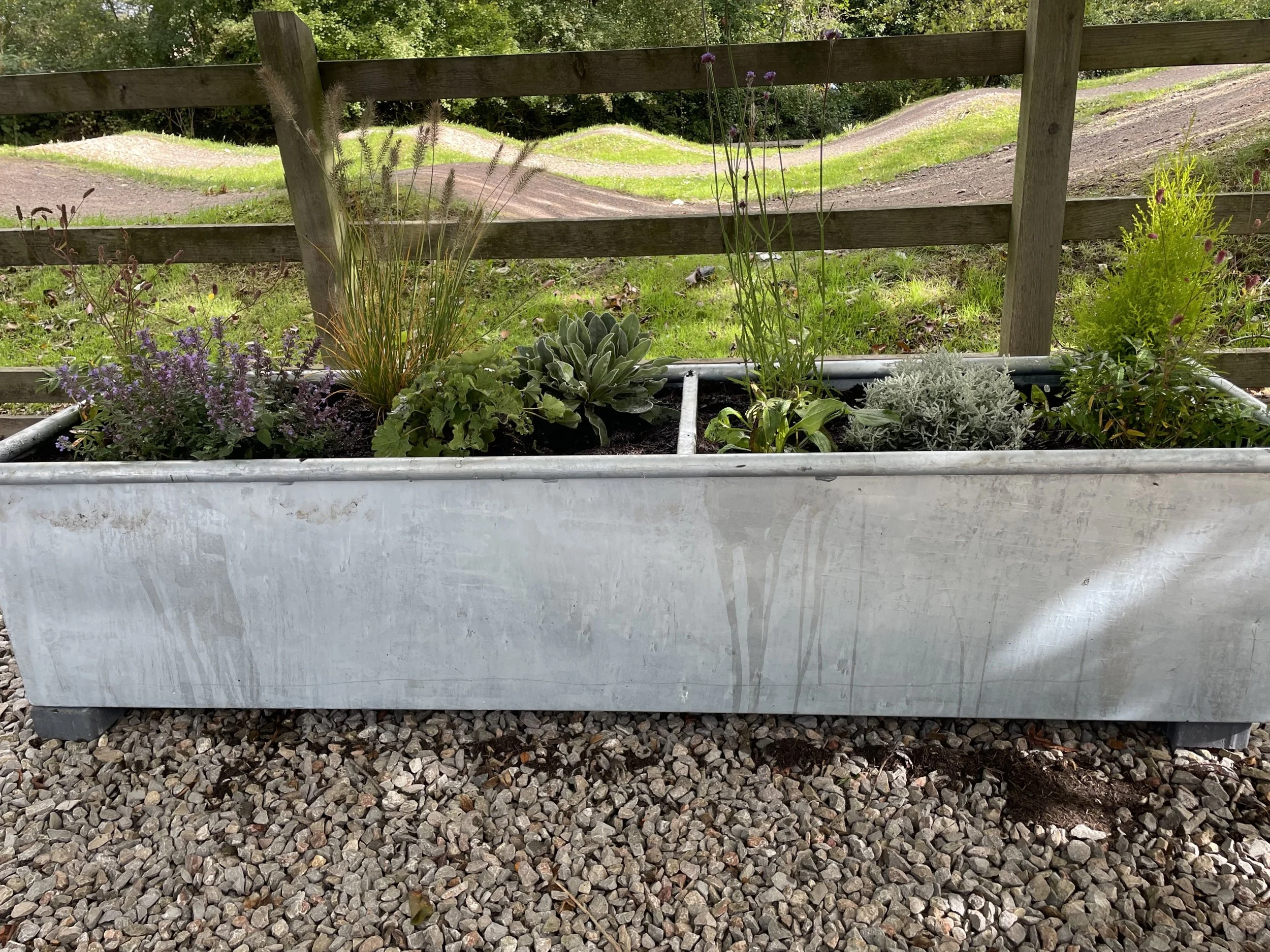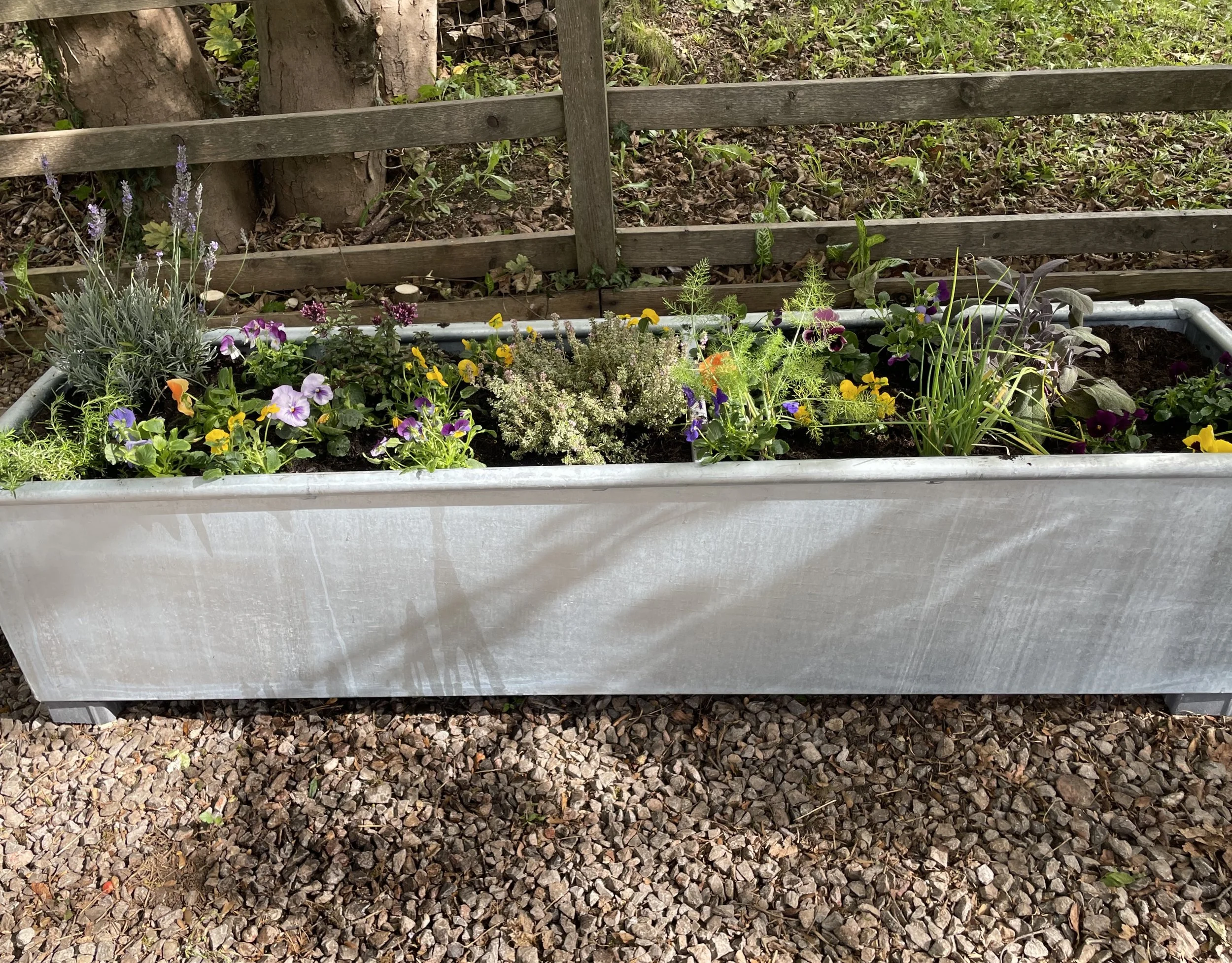Sound
The sense of sound is possibly one of our more complex senses and operates largely on vibrations. Not the Om kind, but through our body’s ability to interpret sound waves through the ear and our nervous system operated by, you guessed it, our brains! There are very tiny bones in the middle of the ear that help not only to hear, but also to keep our equilibrium, our balance, and to help us maintain awareness of our environment as well as communicate.
The sense of sound is possibly one of our more complex senses and operates largely on vibrations. Not the Om kind, but through our body’s ability to interpret sound waves through the ear and our nervous system operated by, you guessed it, our brains! There are very tiny bones in the middle of the ear that help not only to hear, but also to keep our equilibrium, our balance, and to help us maintain awareness of our environment as well as communicate.
In this trough
This trough is mainly about the grasses that make a rustle in the wind. But we’re also looking at the sounds of nature. Grasses produce seed heads that birds like to eat. We’ve also got some flowers on the Persicaria spictis for our Queen Bees, who make a lovely humming noise, and other hibernating pollinators who are no longer going into full hibernation anymore due to more mild winters. We will underplant this trough with lots of early flowering bulbs for all the pollinators to help them with high pollen and nectar sources and bulbs really fit the ticket for this problem.
We start this trough with a Miscanthus Red Chief that almost looks like it has been hair crimped! It’s got red stems on it which will be cut back to make room for the bulbs in spring. Next we’ve got a little evergreen called Carex Praire Fire that gets more orange as the weather turns cold. We have a Japanese blood grass Hakonechloa macra Aureola which starts with a lime green base but ends up at the tips being a beautiful glowing red. The wild ones are used for thatching. The leaves are very waxy, so make good rooves. We also have a Persicaria (amplex’ Speciosa) which is used in lots of prairie plantings that mixes really well with grasses as it gives an elegant spire of flowers to feed the bees, plus the leaves are so beautiful and give a really good rattle with lots of different sounds. The underplanting will be large crocus and large species flowers like irises and Anenomes (Blanda mixed Narcissus Minnow, Blanda blue) along with more multiheaded bulbs that are high energy food for our bees and butterflies.
All video content is provided by Ann Evans of Barters Farm Nurseries Ltd.
Smell
The sense of smell is powerful – some say the most powerful sense we have as it is strongly linked to our emotions and memory. It works by detecting odours that are picked up by tiny sensory cells in your mouth and nose. Your brain then interprets the incoming data and links it to hazards, memories, emotions, food and many other things.
The sense of smell is powerful – some say the most powerful sense we have as it is strongly linked to our emotions and memory. It works by detecting odours that are picked up by tiny sensory cells in your mouth and nose. Your brain then interprets the incoming data and links it to hazards, memories, emotions, food and many other things.
In this trough
We start this trough with an evergreen Eucalyptus (French blue) known widely as the food of Koala bears, but it has grown into a favoured spa treatment for essential oils that sooth the skin and calm the mind, and also clears up the sniffles when you have a cold!
The next plant is a type of Teucrium with interesting spires of flowers. It is an old medieval British plant that was used to feed the bees. It’s a sub shrub, like a lavender, and part of the mint family.
Next to this, we have a very special Daphne which flowers on and off throughout the year and has what’s called an ‘eternal fragrance’.
The next beautiful pink flowered plant is Phlox Bright Eyes which is full of buds that just keep on giving, and it smells like a traditional English garden! We also have a Choisya (White Dazzler) which is sweetly scented like citrus flowers and is a nice evergreen with lacey leaves.
Another form of Teucrium here has the hairs on the leaves again, like the Lamb’s Ear, as it is from a hot, dry climate so it has its built in Factor 50 and is nice and soft to touch. T
he strange looking green stemmed plant is Cytisus Vanessa that has lovely yellow fragrant flowers in spring which bees adore! And we have a miniature lilac with pink flowers that will give us flushes of flowers throughout spring and summer that are divine for pollinators.
We also have a Saracocca confuse which is an evergreen that is called Sweet Christmas Box. The flowers come out near Christmas time, and will give us the Bzzzzzzzzzz of bees over the holiday season! Such a beautifully scented shrub.
We also have an Agastache Blue Boa that smells of liquorice if you have a little rub of its leaves. It also has beautiful spires of flowers, again if you dead head, they just keep on coming and are such a lovely purple colour. We also have a Russian sage called Pervoskia Blue Spire with scented, aromatic leaves with wonderful fluffy buds that open up to blue flowers that are adored by bees.
We will underplant this box with heavily scented Narcissus bulbs (Sir Winston Churchill, Narcissus Pipit, Narcissus Sailboat, Narcissus Yellow Cheerfulness, Narcissus Quail, Hyacinths and Tulip Angelique).
All video content is provided by Ann Evans of Barters Farm Nurseries Ltd.
Touch
Touch allows us to perceive the world through direct skin contact that delivers information to the brain such as pain, pressure and vibration. These notifications allow us to make choices about our emotions and safety. Touch enables us to interact with our environment and develop emotional bonds. Our nerves in the skin are connected to proprioceptors in our muscles and joints which enable us to maintain body awareness that allows for mobility and coordination. The earliest days of our human cognitive and emotional development are based on sensing the world through touch.
Touch allows us to perceive the world through direct skin contact that delivers information to the brain such as pain, pressure and vibration. These notifications allow us to make choices about our emotions and safety. Touch enables us to interact with our environment and develop emotional bonds. Our nerves in the skin are connected to proprioceptors in our muscles and joints which enable us to maintain body awareness that allows for mobility and coordination. The earliest days of our human cognitive and emotional development are based on sensing the world through touch.
This trough has highly tactile plants, starting with the beautiful grass called Foxtails (Pennisetum Hameln/fountain grass) that also provide in its grassy base a great habitat for lots of little beneficial insects. Next we have Achimilla mollis that has acid green flowers that create a great big froth the bees love. You can have a feel of these very soft leaves. The next beautiful plant is Lamb’s Ears which also has lovely soft leaves that are quite fluffy looking and covered in what looks to be tiny little hairs that act as the plants natural defence to preserve water, and these tiny hair-like structures allow them to grow in very hot climates (and also act like Factor 50 sunblock for the leaves!). Then something a little bit coarser nearby that has tall stems that come up to these gorgeous flowers on the tip – called Verbena. This one is a shorter variety called Vanity and the pollinators are going to love it! Then we come across the little conifer Cupressus Goldcrest that can actually be very easily trimmed into little shapes by any helpful volunteers. As it’s trimmed, the reward is a lovely citrus smell that is really fresh and vibrant. Please stroke it, even on a cold day, your warm hand will release that gorgeous fragrance into the air. Our Nepta Purrsian Blue is a dwarf catmint and it is absolutely adored by cats as it relaxes them (and humans, too), but more importantly, loved for a long time seasonally by bees and butterflies from early spring to autumn.
We are underplanting this trough with spring bulbs for the pollinators and we have some short tulips as well as multiheaded narcissus or short daffodils (Tulipa Red Riding Hood, Tulipa Giuseppe Verdi, and Narcissus Tete a tete). Multiheaded flowers allow the bees to maximise their energy spend on flying with lots of nectar and pollen to gather in a very short space of time which really helps when they’re cold.
We have some nice rough course leaves on the Echineacea purpurea plant that will form a lovely seed head on its flower that we leave for the birds in the winter, but have a feel as it isn’t prickly, it’s rubbery! It’s quite a strange feel and the bees adore them. We have another rather floaty grass that also has a great lower habitat for the ladybirds and other pollinators to hibernate within, but in autumn has a rather soft, silky vibrant lime green growth seed head that we call Ponytails (Stipa tenuissima). Another plant that looks like Lamb’s Ears, but is called Lychinus coronarius has tall spires that form bright fuchsia pink flowers that the bees and butterflies adore, and they also like the seedheads of the flowers. Next we have a Cotton Aster Santolina chamaecyarissus that will have bright yellow button flowers in the summer that the pollinators love, but it’s worth a feel of the leaves because they have a rubbery sensation similar to the Echineacea.
All video content is provided by Ann Evans of Barters Farm Nurseries Ltd.
Sight
Sight is one of the most complex senses. The eyes and brain work in tandem with nerves to process depth, light, colour and imagery. Sight is another way of taking in data to inform how we perceive the world to make decisions about our environment, our movement, and our social interactions.
Sight is one of the most complex senses. The eyes and brain work in tandem with nerves to process depth, light, colour and imagery. Sight is another way of taking in data to inform how we perceive the world to make decisions about our environment, our movement, and our social interactions.
In this trough
People see the world in different ways. Depending on whether you have conditions of sight loss like blindness, or colour blindness, cataracts or something else, we have designed this trough to look at good, strong colour contrast so it can be seen by all types of eyes. We think many people will love it because they will be able to see its strong colours, especially the bees!
Starting from the back we have the Sunhat flower known as Rudbeckia. If you have a look at the middle, it has the most wonderful pattern. We then have Astrantia (major Claret) that grows in lots of different conditions, shade and sun, and is made up of lots of different little flowers that make it look like a pin cushion. Another friend of the pollinators is Geum (Lady Strathenden) which is one of the first things to flower and last to stop flowering in traditional English borders. They keep on flushing all the way through to late September.
The underplanting in this trough is to help feed pollinators all year round and continuing on the theme of contrasts, it consists of three types of tulips (Queen of the Night, Purissima and Snakes Head Fritillary) as well as Narcissus Phesant’s eye, the very fragile Anenome Bordeux, and Allium purple sensation which have fantastic seed heads and are strongly scented.
We also have Salvia Caradonna to feed the bees as it keeps flowering and flowering as long as it is regularly dead headed and we also have two Coreopsis (Corleone Gold) with their lovely yellow flower heads as this bed is designed to be symmetrical as our eyes like balance. We also have a special little plant in the middle called Salvia Jamensis Hot Lips that does a very strange thing. When it first starts flowering in late spring, the flowers are completely red, then they go white and red, and again in mid summer, when it’s hotter, they go completely white, and then return back to red and white in autumn before turning completely red again before the winter frost comes. And finally, we have Heuchera which has brilliant little flowers for our pollinator friends and a lovely deep red leaf.
All video content is provided by Ann Evans of Barters Farm Nurseries Ltd.
Taste
The sense of taste is specific to the sensation detected by our taste buds of the five basic tastes of sweet, sour, salty, bitter and umami. Taste is important because it allows us to determine if food is safe to eat. Also, maybe less true in today’s world of fast and overly processed food, it has historically enabled us to distinguish whether something is nutritious and will provide our bodies with the sustenance it requires to thrive.
The sense of taste is specific to the sensation detected by our taste buds of the five basic tastes of sweet, sour, salty, bitter and umami. Taste is important because it allows us to determine if food is safe to eat. Also, maybe less true in today’s world of fast and overly processed food, it has historically enabled us to distinguish whether something is nutritious and will provide our bodies with the sustenance it requires to thrive.
This taste trough is good for pollinators and also for discovering taste through strong scented plants like lavender (Lavender Grosso) that can be used for culinary purposes in dishes such as lavender sugars, ice creams, shortbread and if you give it a little rub of the leaves, the scent is perfumy and heavenly. Next we have variegated lemon scented thyme (Thymus Citriodorus ‘Silver Queen’) that can be used for so many recipes including sprinkling the edible flowers into salads.
There are two planted ‘salad burnets’ (Sanguisorba off pink Tanna) which need to be well pruned in winter or they can become invasive. The leaves have a cucumber scent and when added to salads they have a spicy flavour. We also have some violas and pansies that can both be used as decorations on cakes or salads as they are edible flowers. An old English tradition was to dip either of these flowers into egg whites and then roll in caster sugar which gives them a frosted look that people used on top of christening and wedding cakes.
We have four different kinds of tulips underplanted (Green Land, Menton, Apricot Delight and Apricot Beauty) that will be great for pollinators in spring and have strong scent as well as taste! The Dutch fed themselves during WW2 with tulip bulbs and flowers and today bulbs are used in fancy restaurants – the flowers are stuffed with a sweet ricotta cheese and deep fat fried similar to what we do with a courgette flower.
Next we have purple sage (Salvia off Purpascens) which is a bit more unusual than the green one and can be used for making stuffings for many dishes including chicken and stuffed peppers. We also have a multiple use plant here called fennel (Foeniculum vulgare). It is used traditionally in a lot of Italian cooking for things like pork sausage, and the fronds are good for salads and fish whilst the bulbous bottom parts are generally used in fresh salads.
Carnassi (Camassia leichtlinii caerulea) is a sensational looking flower that was found in North America by the pilgrims who were shown by the natives how to safely use it as food, but it requires special washing first and not safe to eat prior! It is a great plant for early year pollinators, too. The scented Rosemary in the trough is a trailing evergreen that is used for ‘Remembrance’ wreaths and bouquets and if you give it a little rub and sniff, you won’t be sorry! It is used in a lot of Mediterranean dishes.
The mint (Mentha spicata English Lamb) we have planted within the Old Quarry Gardens, not in the trough, as we already have a very large, prolific patch of it growing which is great for mint sauce and mint teas. If you can find your Sixth Sense, then maybe you will find the patch of mint inside during your Treasure Hunt!
There are also lovely chives (Allium schoenoprasum) growing here with tubular leaves you can crush that will smell like onions. Next we have the tall upright rosemary (Rosmarinus off Prostratus) that flowers late winter into spring and is great for the Royal bumblebees and our queens that are laying nests and bringing up little bees during this time.
And last we have oregano (Origanum laevigatum ‘Herrensen’) which is used on many dishes you might like such as pizza and other Italian dishes that use tomato.
All video content is provided by Ann Evans of Barters Farm Nurseries Ltd.





